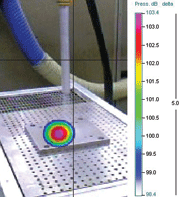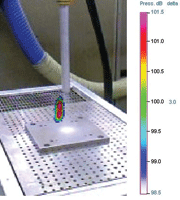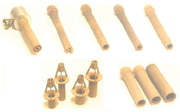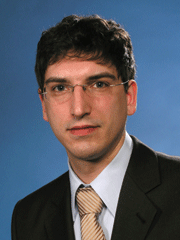E-Archive
Science Update
in Vol. 9 - January Issue - Year 2008
Noise Reduction of Dry Ice Blasting


Fig. 1: Noise sources with dry ice blasting

Fig. 2: Dry ice blasting nozzles made by selective laser sintering

Table 1: Configurations of the blasting nozzles used and their influence on the noise level and the removal performance

Prof. Eckart Uhlmann

Adil El Mernissi

Andr

Robert Hollan
Dry ice blasting is a compressed air blasting process which is based on the combined effect of several mechanisms. They are composed of a thermal mechanism due to the low temperature of solid carbon dioxide (CO2) of -78.5 °C, a mechanical effect due to the kinetic energy of the blasting medium and the sublimation effect because of the direct change of CO2 from the solid to the gaseous phase and therefore a volume increase of about 600-fold /1/. The characteristics of carbon dioxide and the combination of the active mechanisms give the process specific advantages. The blasting medium sublimates during the impact on the surface to be cleaned and can be released into the atmosphere as its natural part. Therefore, installations and machines can be cleaned without disassembling, which allows a significant reduction of the cleaning times. Because of the combined effect of the modes of action and the low hardness of solid carbon dioxide, mechanically sensitive materials and heterogeneous workpieces can be processed with little abrasive and corrosive influence. Nonetheless, the process is flexible in regard to thickness and material of the contamination or coating. Additional advantages in applications in electrical engineering and the food industry result from other characteristics of CO2, like being electrically non-conducting and bacteriostatic.
Motivation
The primary disadvantage of dry ice blasting is the high noise exposure. At a high blasting pressure the process reaches harmful noise levels of up to 130 dB (A). High noise levels also occur in inaudible frequency areas /2/. Present safety measures are based on organisational measures by encapsulating the entire system by sound insulation or on personal safety measures by means of circumaural hearing protection. In this article, possible technical safety measures to avoid the noise origination for blasting nozzles are presented, which were developed in cooperation with the company Otto Littmann Maschinenfabrik Präzisionsmechanik GmbH in a research project funded by Deutsche Bundesstiftung Umwelt DBU.
First, insight about the mechanisms of noise origination in the area of the blasting nozzle design was gained by an analysis with an acoustic camera. Appropriate design measures reduced noise origination without also reducing the performance of the blasting nozzles significantly. Based on a standard blasting nozzle, methods of resolution for noise reduction were developed and implemented. The prototype blasting nozzles were compared with respect to the noise level and removal performance.
Identification of noise source with dry ice blasting
An acoustic camera was used for the acoustic analysis of the dry ice blasting process. It is a light-weight, modular and therefore flexible system for the visual localisation and analysis of sound sources. The base configuration consists of a microphone array, a data recorder, a notebook and the software “NoiseImage”. Therefore a camera model of the company gfai tech GmbH was used. The analysis showed three primary noise sources. Firstly, noise originates within the aperture area through turbulences, where the compressed air jet impinges on still air. The noise also emerges during the impact on the workpiece surface and above a certain blasting pressure in the free jet between the outlet edge and the workpiece surface. The identified noise sources are characterised by different frequency ranges, fig. 1.
Development of methods of resolution for the reduction of noise emission by dry ice blasting
Concepts from the areas of compressed air nozzles and jet engine design are consulted to develop methods of resolution for the noise reduction with blasting nozzles. These concepts can be realised by appropriate design measures:
• Velocity reduction of the acceleration medium
• Improvement of the mixing process with the ambient air
• Reduction of the core jet
• Selection of suitable materials for the blasting nozzle
• Specific adjustment of the surface roughness of the inner geometry of the blasting nozzle
In the first investigations the commingling process was improved. The following measures or combination of noise reduction measures can be applied to blasting nozzles:
• Reduction of the velocity gradient over the profile in the aperture area, e.g. encapsulation of the core jet
• Acceleration of the mixing process by means of suitable nozzle orifice edges, e.g. in meander shapes
Design and manufacturing of low-noise blasting nozzles
After the identification of the noise sources, prototype nozzles with the above mentioned noise reduction measures or combination of these measures were designed and manufactured. The blasting nozzles were manufactured by selective laser sintering (SLS). In the SLS process very fine-grained, powdery plastic is selectively molten by a laser and allows to manufacture parts of arbitrary shape and sufficient precision layer by layer, fig. 2. All nozzle designs have been given the same inner geometry and were manufactured from the same material in order to ensure comparability.
Noise and technological analysis of the blasting nozzles
The noise level and the frequency spectrum were measured for the acoustic analysis. For this purpose an experimental and measuring set-up following Hackstein and Staufenbiel was used /3, 4/. The noise pressure caused by the free jet was recorded by a capacitor microphone. In order to determine the directional characteristics and to measure the noise levels according to DIN EN ISO 3741-3747, the blasting nozzle was moved circularly around the microphone by a robot in a distance of 1 m in the far field in an angle of ?=100 °. The analysis of the removal performance is based on the assessment of the blasting nozzles footprint. The removal performance can be calculated of the blasted trace width of a blasting process of a coated sheet of metal with a given feed speed.
In table 1 the analysed nozzle configurations with the single and combined noise reduction measures are listed. Furthermore, the table shows the percental ascents and descents of the averaged noise level and the removal performance. Depending on the applied measures, noise level reductions in the high one-digit dB (A)-area were reached in some cases, which had a positive effect on the subjective loudness perception at a varying degree. Most nozzle prototypes did not show any significant performance derogation.
Outlook
The above mentioned approaches will be pursued for further research to reduce the noise of blasting nozzles in the field of dry ice blasting as well as blasting nozzles in general. The blasting nozzles will be designed in order to abate the blasting pressure and the flow rate of the compressed air while preferably maintaining the removal performance. The influence of the nozzles' inner surface on the noise emission will be analysed. Independently of the noise reduction, the development will be accelerated by the utilisation of computer-aided flow simulations.
The presented research was made possible by the Deutsche Bundesstiftung Umwelt DBU that provides the funding for the research project “Reducing the Noise Level of Blasting with Solid Carbon Dioxide”.
References
/1/ Krieg, M.: Trockeneisstrahlen - mit Schnee oder mit Pellets? Journal für Oberflächentechnik JOT, Heft 6, 2005, S. 50-55.
/2/ Uhlmann, E.; Elbing, F.: Arbeitsschutz, Sicherheitstechnik und flexible Reinigungstechnologie. Arbeits- und Ergebnisbericht, Teilprojekt A4, Sonderforschungsbereich 281 “Demontagefabriken zur Rückgewinnung von Ressourcen in Produkt- und Materialkreisläufen”, TU Berlin, 2000, S. 119-160.
/3/ Staufenbiel, R.: Verminderung des Lärms von Strahltriebwerken unter Ausnutzung der "inversen Profilierung". Forschungsberichte des Landes Nordrhein-Westfalen, Nr.3197, Westdeutscher Verlag, 1985.
/4/ Hackstein, H.J.: Strömungsmechanische und akustische Untersuchungen an Koaxialstrahlen unterschiedlicher Profilierung. Dissertation, TH-Aachen, 1986
For Information:
Institute for Machine Tools and Factory Management, Technical University Berlin, Germany
Tel. +49.30.314-22413, Fax +49.30.314-25895
E-mail: hollan@iwf.tu-berlin.de



























